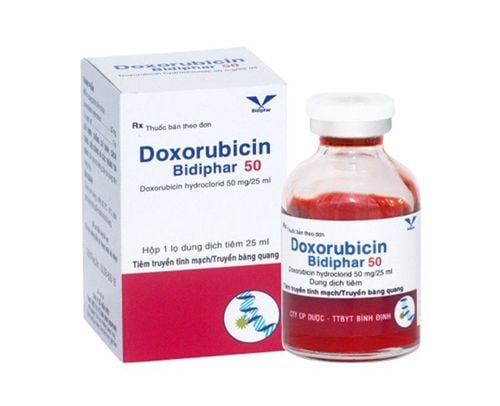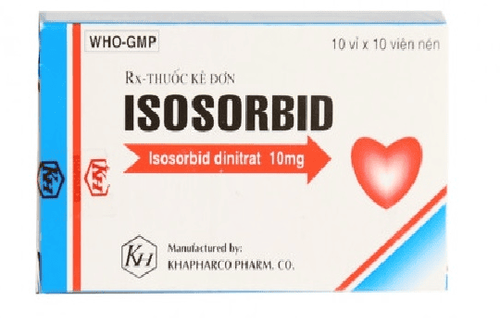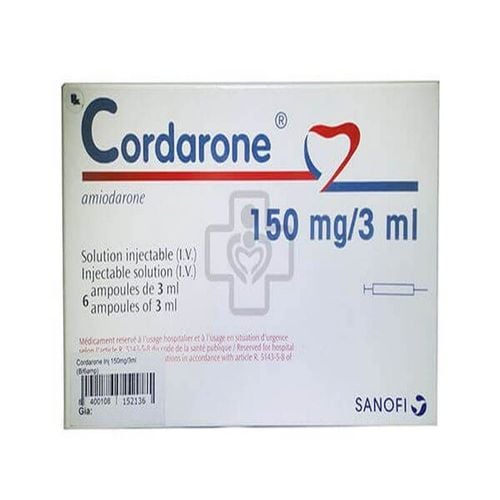This is an automatically translated article.
The article was professionally consulted with Master, Doctor Nguyen Tung Hoanh - Interventional Cardiologist - Department of Resuscitation - Emergency - Vinmec Nha Trang International General Hospital.Cardiac agents used in low-flow heart failure and supraventricular arrhythmias. Cardiac glycosides have the properties of increasing myocardial contractility, slowing heart rate, muscle conduction (conductivity) and increasing excitability of cardiomyocytes.
Cardiac glycosides (CGs) including digitalis, digoxin, and digitoxin are used in the treatment of congestive heart failure associated with atrial fibrillation with rapid ventricular response or heart failure associated with paroxysmal supraventricular tachycardia. The therapeutic benefits of digitalis were first described by William Withering in 1785. Initially, digitalis was used to treat ascites. Subsequent studies have shown digitalis to be most useful for edema caused by a weakened heart (also called heart failure).
1. What is the mechanism of action of cardiac glycosides?
Digitalis compounds are potent inhibitors of cellular Na + / K + -ATPase. This ion transport system moves sodium ions out of the cell and brings potassium ions into the cell. This transport function is essential for cell survival. Loss of these ion gradients will lead to cellular depolarization and loss of the negative membrane potential necessary for normal cell function.
Na + / K + -ATPase also plays an active role in membrane potential. It is electrically charged because it transports 3 sodium ions out of the cell. This can add several negative millivolts to the membrane potential depending on pump operation.
Cardiac cells, like many other cells, have Na + -Ca ++ exchange devices necessary to maintain sodium and calcium homeostasis. The exact mechanism by which this exchanger works is still unclear. It is known that calcium and sodium can move in both directions in the sarcolemma. Furthermore, 3 sodium ions are exchanged for each calcium, so an electric potential is generated by this exchanger. The direction of movement of these ions (inward or outward) depends on the membrane potential and the chemical gradient of the ions. We also know that an increase in intracellular sodium concentration will compete with calcium through this exchange mechanism resulting in increased intracellular calcium concentration. As intracellular sodium increases, the concentration gradient that leads sodium into the cell across the exchanger is reduced, thereby reducing exchanger activity, reducing the movement of calcium out of the cell. Mechanisms leading to intracellular sodium accumulation induce subsequent intracellular calcium accumulation due to decreased exchange pump activity.
By inhibiting Na + / K + -ATPase, cardiac glycosides increase intracellular sodium concentration. This then leads to intracellular calcium accumulation through the Na+-Ca++ exchange system. In the heart, increased intracellular calcium causes the matrix to secrete more calcium, thus producing more calcium to bind to troponin-C, increasing contractility (inotropy). Inhibition of Na + / K + - ATPase in vascular smooth muscle causes depolarization, smooth muscle contraction, and vasoconstriction.
By a mechanism that is not fully understood, digitalis compounds also increase vagal activity on the heart. This parasympathetic action of digitalis reduces the firing rate into the sinoatrial cavity (decreased heart rate, negative movement) and decreases the velocity of electrical impulse conduction through the atrioventricular node (negative motion).
2. What is the toxicity of cardiac glycosides?
The long half-lives of digitalis compounds require special considerations when quantifying. With a half-life of 40 hours, Digoxin would require continuous dosing over several days to achieve steady-state therapeutic plasma concentrations (Digitaloxin with a half-life of 160 hours).
Therefore, at the start of treatment, a special dosing regimen involving a "loading dose" is used to rapidly increase digoxin plasma concentrations. This process is called "digitization". For digoxin, the range of therapeutic plasma concentrations is 0.5 - 1.5 ng/ml.
It is very important not to exceed therapeutic plasma concentrations because digitalis compounds have a relatively narrow therapeutic safety value. Plasma concentrations above 2.0 ng/ml can lead to digitalis toxicity, manifesting as cardiac arrhythmias, some of which can be life-threatening. If toxicity occurs with digoxin, it may take several days for plasma concentrations to fall to safe levels because of the long half-life. Potassium supplementation may also reverse the toxic effects of digoxin if toxicity is associated with hypokalemia.
3. Drug interactions with cardiac glycosides
Many commonly used drugs interact with digitalis compounds. The class IA antiarrhythmic drug, Quinidine competes with digoxin for binding sites and reduces renal clearance of digoxin. These effects increase digoxin concentrations and may produce toxicity. Similar interactions occur with calcium channel blockers and nonsteroidal anti-inflammatory drugs. Other drugs that interact with digitalis compounds are amiodarone (class III antiarrhythmic drugs) and beta blockers. Diuretics may interact indirectly with digoxin because of their ability to decrease plasma potassium levels (i.e. cause hypokalemia). Hypokalemia leads to increased binding of digoxin to Na + / K + -ATPase (possibly through increased phosphorylation of the enzyme) and thereby enhances the therapeutic and detoxifying effects of digoxin. Hypercalcemia increases digitalis-induced intracellular calcium, which can lead to calcium overload and increased susceptibility to digitalis-induced arrhythmias. Hypotension also makes the heart susceptible to digitalis-induced arrhythmias.
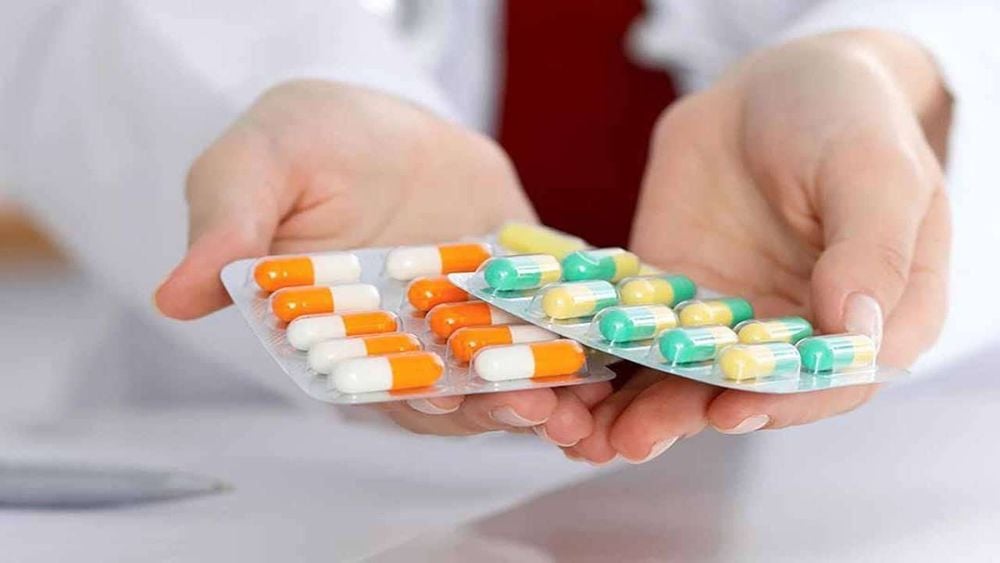
Cần thận trọng với những tương tác thuốc với glycosid tim
4. Main effects of cardiac glycosides
4.1. Congestive heart failure Congestive heart failure occurs when cardiac output is insufficient to meet tissue perfusion needs. Heart failure can primarily be caused by systolic dysfunction or diastolic dysfunction.
Systolic dysfunction: The ventricles are dilated and cannot develop enough wall tension to push the adequate amount of blood. This occurs in ischemic heart disease, valvular insufficiency, dilated cardiomyopathy, myocarditis, and tachyarrhythmias. Diastolic dysfunction: The ventricular wall thickens and fails to relax during diastole, impaired ventricular filling due to low output. It occurs in persistent hypertension, coarctation of the aorta, congenital heart disease, AV shunt, hypertrophic cardiomyopathy. However, most patients, especially with long-standing congestive heart failure, have both systolic and diastolic dysfunction. Cardiac glycosides primarily reduce systolic dysfunction. The best results are obtained when the myocardium is not primarily deranged, e.g. hypertension, valvular defects or tachycardia in atrial fibrillation. The response is poor, there is more toxicity when the myocardium is damaged by ischemic, inflammatory or degenerative changes and thiamine deficiency as well as high output impairment (in anemia).
Cardiac glycosides are unlikely to reverse the pathological changes of congestive heart failure or even halt their progression. With regard to hypertrophy, the myocardium undergoes remodeling that may involve isoform changes of various functional proteins such as myosin, creatine kinase, Na + K + ATPase, etc. Cardiac glycosides do not affect regeneration.
Because of the lower contractile state, the failing heart can pump much less blood at normal filling pressures, more blood remaining in the ventricles at the end of systole. The return of the venous to normal with extra blood helps to increase filling pressure, the heart can reach normal stroke volume, but at filling pressure produces symptoms of congestion (venous tension, edema). swelling, hepatomegaly, pulmonary congestion → dyspnea, renal congestion → oliguria).
Digitalis induces inotropic enhancement that increases ventricular ejection fraction and shifts the stroke output-related curve with filling pressure towards normal, so that adequate output at pressure can be achieved filling without producing symptoms of congestion. The improved tissue perfusion resulted in decreased heart rate sympathetic overactivity and decreased central venous pressure (CVP). Compensatory mechanism retains Na + and water is inactivated → diuresis → stop edema. Regression of liver, reduced pulmonary congestion → shortness of breath, cyanosis disappears. Low output symptoms such as reduced muscle work capacity are minimized.
Usual Dose:
In most mild to moderate cases, a maintenance dose of digoxin (0.125–0.25 mg/day) is given initially. A full response takes 5-7 days to develop, but the process is much safer. In the event that an adequate response is not observed after 1 week, increase the dose to 0.375 and then to 0.5 mg after another week. Assessment of complete response is primarily clinical. Reducing the signs and symptoms of failure, and reducing heart rate and body weight to normal levels is the best guide. Bradycardia (HR <60/min) is an indication to discontinue further medication. ECG changes are of no value in dose quantification, unless arrhythmias are present.
Rapid dosing:
Digoxin 0.5-1.0 mg stat followed by 0.25 mg every 6 hours carefully monitored and watched for toxicity to reaction - usually takes 6-24 hours (total dose 0.75-1.5 mg). Emergency Dosage:
It is rarely done, only as a last resort in CHF or atrial fibrillation. Digoxin 0.25 mg then 0.1 mg hourly by slow intravenous injection with close monitoring of ECG, BP, and CVP until response (2–6 hours, total dose 0.5–1) ,0 mg). 4.2. Atrial fibrillation and flutter Atrial flutter and flutter resulting in ventricular tachycardia can decrease ventricular filling capacity (due to reduced filling time) and decrease cardiac output. Furthermore, chronic ventricular tachycardia can lead to heart failure. Digitalis compounds, such as digoxin, are useful for reducing ventricular rate when it is driven by high atrial rate. The mechanism of this beneficial effect of digoxin is its ability to activate the vagus nerves to the heart (parasympathetic effects). Vaginal activation can reduce electrical impulse conduction in the atrioventricular node to the point where some impulses will be blocked. When this happens, fewer impulses reach the ventricles and the ventricular rate decreases. Digoxin also increases the effective refractory period in the atrioventricular node.
Atrial fibrillation (AFI) The atrial rate is 200–350/min (less than in AF), but the atrial contractions are regular and synchronized. A varying degree of AV block, depending on the average ERP of the AV node, is naturally established. Digitalis enhances this AV block, reduces the ventricular rate, and prevents the abrupt shift of AV block to a lower degree (which can occur with exercise or sympathetic stimulation). Digitalis is able to convert AFl to AF by reducing the atrial ERP and making it heterogeneous. This is a welcome response because ventricular rate control is easier in AF (hierarchical response occurs) than in AFl (step-varying AV block). In nearly 1⁄2 of patients when digitalis is stopped, this induced AF reverts to sinus rhythm because the cause of the atrial heterogeneity has disappeared.
Paroxysmal supraventricular tachycardia (PSVT) This is a common arrhythmia with a rate of 150–200/min and 1:1 atrioventricular conduction. It is mainly due to retry involving the SA node or AV button. The rigidly limited magnitudes of the ERP and conduction velocity are necessary for its persistence. Parenteral glycosides can be given IV—increasing vagal tone and decreasing SA/AV node conduction pathways or ectopic foci and cessation of arrhythmias (successful in 1/3 of cases) . Verapamil/adenosine is more effective, less toxic, and acts faster. Digitalis is currently dedicated to preventing recurrence in select cases.
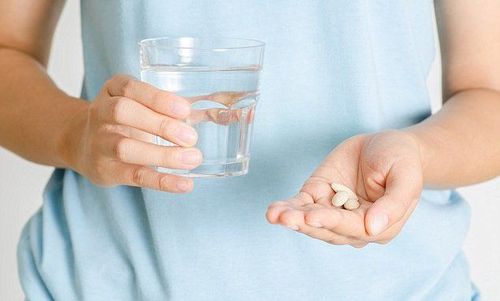
Người bệnh cần dùng glycosid tim theo đúng liều lượng được chỉ định
5. Side effects
Digitalis toxicity is high, safety is low (therapeutic index 1.5–3). Higher rates of cardiac death have been reported in patients with stable digoxin plasma concentrations >1.1 ng/ml during maintenance therapy. Approximately 25% of patients develop one or more symptoms of toxicity.
The systemic manifestations are:
Anorexia, nausea, vomiting and abdominal pain caused by gastric irritation, mesenteric vasoconstriction and CTZ stimulation. Fatigue, unwillingness to walk or lift arms, irritability, headache, psychosis, restlessness, hyperpnoea, disorientation, mental confusion and visual disturbance are other complaints. Diarrhea occurs occasionally. Skin rashes and gynecomastia are rare. Cardiac manifestations:
Almost any type of arrhythmia can be produced by digitalis: pulsus bigeminus, ventricular nodal and extrasystoles, ventricular tachycardia and terminal fibrillation. Partial to complete AV block may be the sole cardiotoxicity or it may be associated with other arrhythmias. Severe bradycardia, atrial extrasystoles, AF or AFl have also been reported. In about two-thirds of patients presenting with toxicity, symptoms of pre-cardiac extrasystoles; the rest severe arrhythmia is the first manifestation. The central actions of digitalis appear to contribute to the development of arrhythmias by causing rapid and irregular activity in the sympathetic and vagus nerves of the heart.
6. Treatment
Subsequent doses of digitalis must be discontinued at the earliest sign of toxicity; No further action is needed in many patients, especially if the presentation is only extrasystoles.
For tachyarrhythmias: When they are caused by chronic use of digitalis and diuretics (both of which cause K+ depletion) —use KCl 20 mmol/hour (maximum 100m.mol) iv or given orally in milder cases. K+ tends to antagonize digitalis causing enhanced autophagy and decreased binding of the glycoside to Na + K + ATPase by favoring a conformation of the enzyme with a lower affinity for cardiac glycosides. In acute intoxication with large doses of digitalis, plasma K + may be high; it should not be provided from outside. In all cases, serum K+ should be measured to guide KCl therapy. K+ is contraindicated if the degree of AV block is higher: complete and non-ventricular AV block may be precipitated. For ventricular arrhythmias: Lidocaine IV repeated on demand is the drug of choice. It prevents excessive automatism, but does not highlight the AV block. Phenytoin is also effective but is now rarely used, as sudden death has occurred with IV injection in patients with digitalis intoxication. Quinidine and procainamide are contraindicated. For supraventricular arrhythmias: Propranolol can be given intravenously or orally depending on the urgency. For AV block and bradycardia: Atropine 0.6–1.2 mg may be helpful; if not, pacemaker should be done by machine. Cardiac cardioversion with DC shock is contraindicated because of the severe conduction defects that may manifest in the digitalis toxic heart. Attempts to enhance digitalis clearance with diuretics or hemodialysis have not been highly effective.
7. Cardiac glycosides
Three different digitalis compounds (cardiac glycosides) are listed in the table below. The most commonly used compound is digoxin. Ouabain is used primarily as a research tool.
| Thuốc uống | Hấp thụ | Thời gian bán hủy (giờ) | Đào thải |
| Digoxin | 75% | 40 | Thận |
| Digitoxin | > 90% | 160 | Gan |
| Ouabain | 0% | 20 | Thận |
In summary, cardiac glycosides including digitalis, digoxin, and digitoxin are used in the treatment of congestive heart failure and atrial fibrillation. They represent a family of compounds derived from fox holster (Digitalis purpurea). The benefit of digitalis is to treat edema caused by a weakened heart.
Please dial HOTLINE for more information or register for an appointment HERE. Download MyVinmec app to make appointments faster and to manage your bookings easily.





